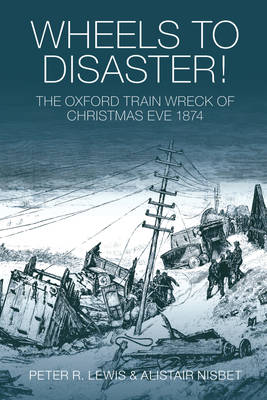
Je cadeautjes zeker op tijd in huis hebben voor de feestdagen? Kom langs in onze winkels en vind het perfecte geschenk!
- Afhalen na 1 uur in een winkel met voorraad
- Gratis thuislevering in België vanaf € 30
- Ruim aanbod met 7 miljoen producten
Je cadeautjes zeker op tijd in huis hebben voor de feestdagen? Kom langs in onze winkels en vind het perfecte geschenk!
- Afhalen na 1 uur in een winkel met voorraad
- Gratis thuislevering in België vanaf € 30
- Ruim aanbod met 7 miljoen producten
Zoeken
Wheels to Disaster!
The Oxford Train Wreck of Christmas Eve 1874
Peter Lewis, Alistair Nisbet
Paperback | Engels
€ 25,45
+ 50 punten
Omschrijving
The development of railways in Britain came in the 1830s as a result of the needs of industry and of a public eager for the novelty and cheapness of rail travel. These early railways were beset by accidents caused by collisions and mechanical failure, and the 1870s produced more disasters than any other decade before or since. On Christmas Eve in 1874 the worst accident in the history of the GWR occurred at Shipton-on-Cherwell when the 10 A.M. from London Paddington to Birkenhead derailed, killing 34 passengers. The fracture of a single tire was enough to cause this catastrophe due to the lack of continuous braking and inadequate communication between the driver and passengers. The authors detail the history surrounding this tragic event using the accounts of eyewitnesses, archive newspaper articles, and reports.
Specificaties
Betrokkenen
- Auteur(s):
- Uitgeverij:
Inhoud
- Aantal bladzijden:
- 224
- Taal:
- Engels
Eigenschappen
- Productcode (EAN):
- 9780752445120
- Verschijningsdatum:
- 1/05/2008
- Uitvoering:
- Paperback
- Formaat:
- Trade paperback (VS)
- Afmetingen:
- 170 mm x 246 mm
- Gewicht:
- 566 g

Alleen bij Standaard Boekhandel
+ 50 punten op je klantenkaart van Standaard Boekhandel
Beoordelingen
We publiceren alleen reviews die voldoen aan de voorwaarden voor reviews. Bekijk onze voorwaarden voor reviews.









